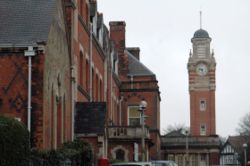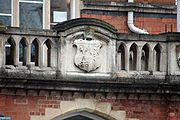
Sutton Coldfield Town Hall
Encyclopedia

Sutton Coldfield
Sutton Coldfield is a suburb of Birmingham, in the West Midlands of England. Sutton is located about from central Birmingham but has borders with Erdington and Kingstanding. Sutton is in the northeast of Birmingham, with a population of 105,000 recorded in the 2001 census...
, England
England
England is a country that is part of the United Kingdom. It shares land borders with Scotland to the north and Wales to the west; the Irish Sea is to the north west, the Celtic Sea to the south west, with the North Sea to the east and the English Channel to the south separating it from continental...
. The building is a Grade A locally listed building.
The town hall's position on the edge of a steep slope means that it has views over large areas of south Sutton Coldfield whilst the northern area remains at the same or similar gradient.
Municipal buildings in Sutton Coldfield
A moot hallMoot hall
A moot hall is meeting or assembly building, traditionally to decide local issues.In Anglo-Saxon England, a low ring-shaped earthwork served as a moot hill or moot mound, where the elders of the hundred would meet to take decisions. Some of these acquired permanent buildings, known as moot halls...
was built in Sutton Coldfield during the time of John Vesey, Bishop of Exeter
John Vesey
John Vesey or Veysey was an English bishop.-Life:He was born John Harman, probably about 1462, the son of a yeoman farmer, in a farmhouse now known as Moor Hall Farm, Sutton Coldfield...
at a site at the top of Mill Street. It was demolished following structural instability caused by the collapse of an upper floor due to the weight of crowds attending the funeral of Thomas Dawney in 1671. There were no fatalities or serious injuries.
A second moot hall was constructed on the same site soon after demolition. It remained in use up until 1854 when it too became structurally unsafe resulting in its demolition. The decision was taken for the workhouse
Workhouse
In England and Wales a workhouse, colloquially known as a spike, was a place where those unable to support themselves were offered accommodation and employment...
and gaol to be renovated and turned into municipal offices. This was rebuilt in 1859 to better suit its purpose. The buildings were converted into a masonic hall upon the opening of the new town hall.
The almshouse
Almshouse
Almshouses are charitable housing provided to enable people to live in a particular community...
s beneath the building were removed in 1924 and the occupants moved to newly constructed almshouses in Walmley
Walmley
Walmley is an area of Sutton Coldfield, England. It is in south Sutton Coldfield, near to Minworth, Wylde Green, Erdington and south of Thimble End. It is approximately northeast of Birmingham city centre...
, in the southern area of Sutton Coldfield.
History of the building

In 1865 the Royal Hotel was built on a small eminence above the newly opened railway station
Sutton Coldfield railway station
Sutton Coldfield railway station is the main railway station for the town of Sutton Coldfield in the West Midlands. It is situated on the Redditch-Birmingham New Street-Lichfield Cross-City Line 7½ miles north east of Birmingham New Street....
to serve the needs of visitors to the town. Throughout its short life, the hotel was beset with financial difficulties and closed in 1895. For a short time, the building was occupied by the Sutton Coldfield Sanatorium, but in December 1901, was sold for £9,000 to the Sutton Corporation to serve as Council Offices. The old Town Hall, in Mill Street, was sold in February 1903 and the Corporation began an ambitious extension to the building to provide a purpose built Town Hall comprising Council Chambers, Assembly Rooms and a Fire Station.
The extension was completed at a cost of £10,000 and opened as Sutton Coldfield Town Hall on September 19, 1906 by the Mayor, Councillor R. H. Sadler, though the fire headquarters had been opened a few months earlier. The opening event was an evening concert by the Sutton Coldfield Choral Society. The following night, an amateur dramatic performance of The Duke of Killicrankie was given by A. C. Fraser Wood and Company. All operations were moved from the previous town hall on Mill Street to the new building. The area to the front of the town hall, King Edwards Square, became the main public assembly area and the stocks
Stocks
Stocks are devices used in the medieval and colonial American times as a form of physical punishment involving public humiliation. The stocks partially immobilized its victims and they were often exposed in a public place such as the site of a market to the scorn of those who passed by...
were displayed to the public in the square (now on display at Blakesley Hall
Blakesley Hall
Blakesley Hall is a Tudor hall on Blakesley Road in Yardley, Birmingham, England. It is one of the oldest buildings in Birmingham and is a typical example of Tudor architecture with the use of darkened timber and wattle-and-daub infill, with an external lime render which is painted white...
).
In 1919, the town hall was used as a theatre for discharged and demobilized men who had fought in World War I
World War I
World War I , which was predominantly called the World War or the Great War from its occurrence until 1939, and the First World War or World War I thereafter, was a major war centred in Europe that began on 28 July 1914 and lasted until 11 November 1918...
. It remained as such up until 1934 having hosted productions such as The School for Scandal
The School for Scandal
The School for Scandal is a play written by Richard Brinsley Sheridan. It was first performed in London at Drury Lane Theatre on May 8, 1777.The prologue, written by David Garrick, commends the play, its subject, and its author to the audience...
, A Midsummer Night's Dream
A Midsummer Night's Dream
A Midsummer Night's Dream is a play that was written by William Shakespeare. It is believed to have been written between 1590 and 1596. It portrays the events surrounding the marriage of the Duke of Athens, Theseus, and the Queen of the Amazons, Hippolyta...
and The Merchant of Venice
The Merchant of Venice
The Merchant of Venice is a tragic comedy by William Shakespeare, believed to have been written between 1596 and 1598. Though classified as a comedy in the First Folio and sharing certain aspects with Shakespeare's other romantic comedies, the play is perhaps most remembered for its dramatic...
.

Birmingham
Birmingham is a city and metropolitan borough in the West Midlands of England. It is the most populous British city outside the capital London, with a population of 1,036,900 , and lies at the heart of the West Midlands conurbation, the second most populous urban area in the United Kingdom with a...
in 1974, the Town Hall became redundant and was required to change its usage. During the transformation, the original elegant and elaborate architecture to minor details were retained. The original interior decor, which is equally detailed, remained however some has been removed due to damage. The tower, which rises from one of the main entrances, has a clock face on all four sides. When first opened, the clock tower also served as a hose tower and a ventilation shaft for the fire headquarters. The Sutton Coldfield coat of arms, which was absorbed into the Birmingham Coat of Arms
Coat of arms of Birmingham
The coat of arms of Birmingham is the heraldic emblem of the English city of Birmingham. It was first used in 1838 and has been changed several times since, as the former town grew and developed into a city.- Incorporation :...
, is located above the entrance.
War memorial
Standing outside the town hall in King Edward Square is a war memorialWar memorial
A war memorial is a building, monument, statue or other edifice to celebrate a war or victory, or to commemorate those who died or were injured in war.-Historic usage:...
commemorating those who died in World War I. Unveiled on November 1, 1922, it consists of single 1.8 metre bronze figure on a 4.6 metre Dalbeattie
Dalbeattie
Dalbeattie is a town in Dumfries and Galloway , Scotland.Dalbeattie is situated in a wooded valley on the Urr Water east of Castle Douglas and south west of Dumfries...
granite
Granite
Granite is a common and widely occurring type of intrusive, felsic, igneous rock. Granite usually has a medium- to coarse-grained texture. Occasionally some individual crystals are larger than the groundmass, in which case the texture is known as porphyritic. A granitic rock with a porphyritic...
pedestal. Inscribed in the pedestal is:
Erected to the glorious memory of the men of Sutton Coldfield who gave their lives in the Great War 1914-1919; and they died that we may live.
The memorial was subject to debate immediately after the war. The design by Francis-Doyle Jones was selected by the Sutton Coldfield District Council committee in November 1919 and he promised not to produce a model like it anywhere else in Warwickshire
Warwickshire
Warwickshire is a landlocked non-metropolitan county in the West Midlands region of England. The county town is Warwick, although the largest town is Nuneaton. The county is famous for being the birthplace of William Shakespeare...
and in only two other locations in the rest of the United Kingdom. The cost of the memorial was met by the Voluntary Subscription Fund. Doyle-Jones had prepared his clay model by March 1922 and the bronze figure was completed on by July 1922. Doyle-Jones was paid £1,650. The memorial was intended to be unveiled on August 31, 1922, however, delays caused by the stonemason set this date back to November 1. The memorial was restored in 1979.
The town hall at present
The town hall is now a theatre and a centre for social functions. Large joint productions by Bishop Vesey's Grammar SchoolBishop Vesey's Grammar School
Bishop Vesey's Grammar School is a selective state grammar school in Sutton Coldfield, Birmingham. Founded in 1527, it is one of the oldest schools in the United Kingdom. The school was a day and boarding school until the 1880s, and retained a small number of boarders in the mid-20th century...
and Sutton Coldfield Grammar School for Girls
Sutton Coldfield Grammar School for Girls
Sutton Coldfield Grammar School for Girls is a state-funded selective grammar school and sixth form college for girls in Sutton Coldfield, Birmingham, West Midlands, England...
are performed at the town hall. Concerts are also performed there with recent performers being the CBSO
City of Birmingham Symphony Orchestra
The City of Birmingham Symphony Orchestra is a British orchestra based in Birmingham, England. The Orchestra's current chief executive, appointed in 1999, is Stephen Maddock...
. It is also a wedding venue.
The annexe of the building is also used as the Sutton Coldfield constituency office for Birmingham City Council
Birmingham City Council
The Birmingham City Council is the body responsible for the governance of the City of Birmingham in England, which has been a metropolitan district since 1974. It is the most populated local authority in the United Kingdom with, following a reorganisation of boundaries in June 2004, 120 Birmingham...
. The small car parking area to the front of the town hall is known as King Edward's Square.
On October 9, 2006, work to repair the roof and refurbish the building. It will cost £46,000 and take 20 weeks to complete. Areas of the building in need of repair included the roof of the Vesey Lounge which was leaking, with water affecting both the internal decoration and the lounge's carpet.

